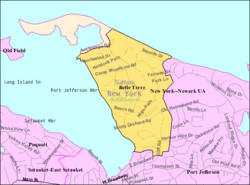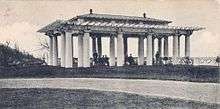Belle Terre, New York
| Belle Terre, New York | |
|---|---|
| Village | |
| Incorporated Village of Belle Terre | |
|
The Belle Terre Gatehouse, a beaux arts structure dating to the first decade of the 1900s | |
 U.S. Census Map | |
 Belle Terre, New York Location within the state of New York | |
| Coordinates: 40°57′37″N 73°4′5″W / 40.96028°N 73.06806°WCoordinates: 40°57′37″N 73°4′5″W / 40.96028°N 73.06806°W | |
| Country | United States |
| State | New York |
| County | Suffolk |
| Area | |
| • Total | 0.9 sq mi (2.3 km2) |
| • Land | 0.9 sq mi (2.3 km2) |
| • Water | 0.0 sq mi (0.0 km2) |
| Elevation | 161 ft (49 m) |
| Population (2010) | |
| • Total | 792 |
| • Estimate (2016)[1] | 783 |
| • Density | 880/sq mi (340/km2) |
| Time zone | Eastern (EST) (UTC-5) |
| • Summer (DST) | EDT (UTC-4) |
| ZIP code | 11777 |
| Area code(s) | 631 |
| FIPS code | 36-05672 |
| GNIS feature ID | 0943606 |
| Website |
www |
Belle Terre is a village in the town of Brookhaven on the North Shore of Long Island in Suffolk County, New York, United States. The population was 792 at the 2010 census.[2]
History


The peninsula on which the community of Belle Terre is situated has been known as Mt. Misery since the 17th century. Before Belle Terre's modern existence, the area was referred to as Mt. Misery Point. By comparison, the lower portion of the peninsula, which is currently a section of the neighboring village of Port Jefferson, was referred to as Mt. Misery Neck.
Throughout the 1700s and 1800s, the bulk of the peninsula was owned by the Strong family, who had their Oakwood estate in its Mt. Misery Neck section. The first known dwelling in contemporary Belle Terre was a shack constructed by an African-American affectionately known as Uncle Mott in the 1800s. This house was the subject of a painting by local artist William Moore Davis.
In 1902, the Port Jefferson Company purchased the Oakwood estate with the purpose of creating an exclusive waterfront development of fifty houses to rival the communities of Long Island's traditional Gold Coast. The well-connected real-estate developer, Dean Alvord, was chosen as president of Belle Terre's estates, which was incorporated in 1906. The construction of the Belle Terre Club, a grandiose private members club at the center of the community, also occurred in 1906. A pair of stately pergolas were constructed as well, which overlook the waterfront.
The Belle Terre Club was destroyed in a fire in 1934, the same year as the pergolas were deconstructed due to the financial burden of their upkeep. Due to a lapse in insurance coverage, the clubhouse was never rebuilt although a new country club opened in the Port Jefferson section of the Mt. Misery peninsula in 1956.
During the 1920s and 1930s, the community's residents staged a successful campaign against sand and gravel companies who began dredging operations in the area. Prior to these companies being ordered to cease operations in 1931, the Seaboard Sand & Gravel Company dredged a large cove near the tip of the peninsula. This is today known as Pirates Cove and is a popular feature of Port Jefferson Harbor among boaters.
For several decades prior to her death in 2014, Belle Terre was the principal home of Nadia de Navarro Farber, a Bulgarian-born countess (by her second of four marriages) who donated considerably to the John T. Mather Memorial Hospital in neighboring Port Jefferson Village. Farber alternated her residence between a landmark pink mansion near the tip of Belle Terre and her castle on the Caribbean island of Saint Croix. The pink mansion was featured prominently in the 1989 film She-devil.
Geography
Belle Terre is located at 40°57′37″N 73°4′5″W / 40.96028°N 73.06806°W (40.9628083, -73.068439).[3]
According to the United States Census Bureau, the village has a total area of 0.9 square miles (2.3 km2), all of it land.
The village occupies the northeastern half of the Mt. Misery peninsula and overlooks both Port Jefferson Harbor and the Long Island Sound. All access to the village over land is from the neighboring village of Port Jefferson, which serves as Belle Terre's nearest commercial center and transit hub.
Demographics
| Historical population | |||
|---|---|---|---|
| Census | Pop. | %± | |
| 1940 | 89 | — | |
| 1950 | 120 | 34.8% | |
| 1960 | 295 | 145.8% | |
| 1970 | 678 | 129.8% | |
| 1980 | 826 | 21.8% | |
| 1990 | 839 | 1.6% | |
| 2000 | 832 | −0.8% | |
| 2010 | 792 | −4.8% | |
| Est. 2016 | 783 | [1] | −1.1% |
As of the census[5] of 2010, there were 792 people, 286 households, and 224 families residing in the village. The racial makeup of the village was 92.6% White, 1.3% African American, 3.3% Asian, 1.3% from other races, and 1.5% from two or more races. Hispanic or Latino of any race were 3.9% of the population.
There were 286 households out of which 30.8% had children under the age of 18 living with them, 72.0% were married couples living together, 2.1% had a male householder with no wife present, 4.2% had a female householder with no husband present, and 21.7% were non-families. 15.7% of all households were made up of individuals and 9.4% had someone living alone who was 65 years of age or older. The average household size was 2.77 persons and the average family size was 3.10 persons.
As of the census[6] of 2000, the population density was 952.3 people per square mile (369.2/km²). There were 297 housing units at an average density of 339.9 per square mile (131.8/km²).
In the village, the population was spread out with 24.8% under the age of 18, 3.6% from 18 to 24, 21.9% from 25 to 44, 36.5% from 45 to 64, and 13.2% who were 65 years of age or older, and the median age for the village was 45 years. For every 100 females, there were 100.5 males and for every 100 females age 18 and over, there were 98.1 males.
The median income for a household in the village was $132,155, and the median income for a family was $144,708. Males had a median income of $100,000 versus $50,156 for females. The per capita income for the village was $56,191. None of the families and 1.4% of the population were living below the poverty line, including none under the age of 18 and 3.2% of those over the age of 64.
Belle Terre v. Boraas
Belle Terre is known for a law that evicted students from a nearby university campus, the State University of New York at Stony Brook, who were leasing shared housing in the village. In Village of Belle Terre v. Boraas,[7] the United States Supreme Court, an opinion written by Justice William O. Douglas held that it was constitutional to forbid more than two people unrelated by blood, adoption, or marriage — not counting household servants — from living and cooking together as a single housekeeping unit in the village for the purpose of maintaining a quiet residential sector.
References
- 1 2 "Population and Housing Unit Estimates". Retrieved June 9, 2017.
- ↑ "Geographic Identifiers: 2010 Demographic Profile Data (G001): Belle Terre village, New York". U.S. Census Bureau, American Factfinder. Retrieved December 19, 2012.
- ↑ "US Gazetteer files: 2010, 2000, and 1990". United States Census Bureau. 2011-02-12. Retrieved 2011-04-23.
- ↑ "Census of Population and Housing". Census.gov. Archived from the original on May 12, 2015. Retrieved June 4, 2015.
- ↑ "American FactFinder". United States Census Bureau. Archived from the original on 2013-09-11. Retrieved 2016-10-20.
- ↑ "American FactFinder". United States Census Bureau. Archived from the original on 2013-09-11. Retrieved 2008-01-31.
- ↑ 416 U.S. 1 (1974) Belle Terre v. Boraas
.jpg)